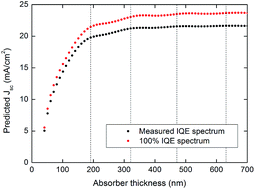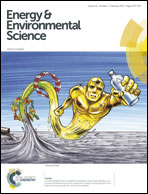Optical properties and limiting photocurrent of thin-film perovskite solar cells†
Abstract
Metal-halide perovskite light-absorbers have risen to the forefront of photovoltaics research offering the potential to combine low-cost fabrication with high power-conversion efficiency. Much of the development has been driven by empirical optimisation strategies to fully exploit the favourable electronic properties of the absorber layer. To build on this progress, a full understanding of the device operation requires a thorough optical analysis of the device stack, providing a platform for maximising the power conversion efficiency through a precise determination of parasitic losses caused by coherence and absorption in the non-photoactive layers. Here we use an optical model based on the transfer-matrix formalism for analysis of perovskite-based planar heterojunction solar cells using experimentally determined complex refractive index data. We compare the modelled properties to experimentally determined data, and obtain good agreement, revealing that the internal quantum efficiency in the solar cells approaches 100%. The modelled and experimental dependence of the photocurrent on incidence angle exhibits only a weak variation, with very low reflectivity losses at all angles, highlighting the potential for useful power generation over a full daylight cycle.

- This article is part of the themed collection: 2015 most accessed Energy & Environmental Science articles

 Please wait while we load your content...
Please wait while we load your content...